
De luxe Zai hole diagram. Zai holes can increase the growth of grains, vegetables and trees, especially in infertile soils in drier climates or seasons. The De luxe Zai hole provides additional aids to growth. Invention and illustration by David Clode.
Zai holes, Tumbukiza, Demi-lunes, Half-moons, Multifunctional Demi-lunes, Planting pits, roof gardens, circle gardens, vertical gardens.
January 2023. I would like to recommend the following web site (in French):
*
Why Zai holes?
Zai holes can increase crop yield by 40% through to 600% compared with standard row cropping in some situations.
Newspaper Zai holes in dry climates and well drained soils may produce about 50% more yield for shallow-rooted vegetables compared with traditional Zai holes.
Zai holes within demi-lunes may produce even more (possibly three-fold or more) than Zai holes or demi-lunes by themselves, in drier climates.
*
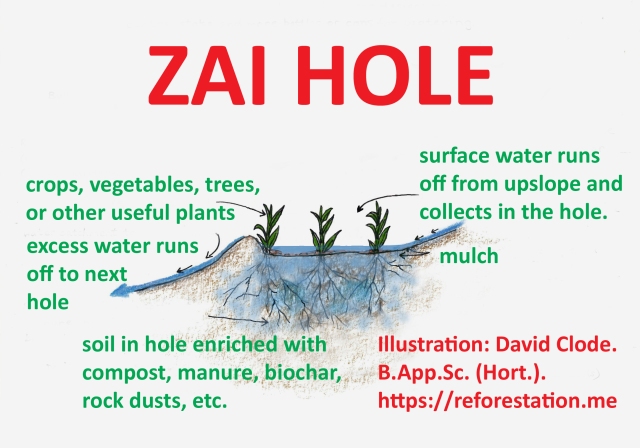
Traditional Zai hole. On sloping ground, the space upslope from the hole acts as a catchment for rain, and the water then flows into the hole instead of continuing to flow down the slope and being lost. A rim or bund of soil around the lower half of the hole contains the water so that it has time to sink in. When the hole is dug, manure or compost is mixed into the soil and placed back into the Zai pit. The combination of soil improved with organic matter and more water catchment can result in major growth increases for crops, vegetables, trees or other useful plants. This technique is particularly effective in well drained infertile soils with little organic matter, and soils where water does not sink in easily, and dry climates or seasons. Invented in Africa and improved by Yacouba Sawadogo. Illustration: David Clode.
*
*
Introduction
Zai holes are a planting pit invented in West Africa, and further developed by Yacouba Sawadogo. They are used to greatly increase the productivity of grains such as sorghum and millet, particularly in the hot and dry Sahel region of West Africa. They have since been successfuly used for growing many other plants, for example: maize, beans, soybeans, yams, sugar cane, fodder grasses, papaya, bananas, many vegetables, and tree species, around the world.
Zai holes have a rim or ridge of soil on the lower side to capture water (on sloping ground, up to 5% slope) and they concentrate water and nutrients (from added manure, compost, rock dusts, ash, fertilizer, urine, etc.) around the plant roots. This combination increases plant growth, especially in free draining, infertile sandy soils, and in hot dry climates (or seasons). In rainfall zones receiving 350 to 600 mm per annum, holes are typically 20 – 40 cm in diameter (round, square or rectangular), 10 – 20 cm deep, and 60 – 100 cm apart. Sizes have tended to become larger in recent times, with a trial in Kenya identifying 60 cm wide by 45 cm deep as optimal for cowpeas, for example. Also, in areas with rainfall higher than 600 mm per annum, or on steeper slopes, larger sizes are more stable.
Zai holes/pits can also work on level ground with a rim or ridge of soil in a circle/ring, or square, around the hole (to hold water and allow it to infiltrate into the pit, plus more compost or manure and mulch can be added later in the growing season).
A significant negative aspect to Zai holes is the manual labour involved in digging large numbers of them. The recently developed sugar cane ring pit culture technique in India, using a tractor and an auger, could be adapted and possibly reduce labour, with the upslope soil placed back in the hole, and the excavated downslope soil retained as a crescent-shaped bund to capture and retain runoff water. This is more like a demi-lune (half-moon), but compost could be mixed into perhaps 30 cm wide and deep pockets, and planted/sown, within the demi-lune (see further down this page for a link demonstrating increased productivity in Zai holes within demi-lunes or half-moons).
February 2024: It is well worth visiting the channel, “Andrew Millison” on YouTube, to watch the video “How the UN is holding back the Sahara Desert”. About half moons and the Great Green Wall in Senegal, West Africa.
September 2023: a few more papers on Zai holes:
fsufs-05-714212ZaiSorghumKenya
PIIS2405844021021083ZaiVsConventionalBCR
In the paper above, conventional row culture with the same inputs of tithonia leaves, compost, or chemical fertilizers, found that conventional row culture had a better benefit/cost ratio compared with Zai holes. The main cost is the labour involved in digging Zai holes, however the perception of this cost depends on the cost of labour, the availability of labour or the lack thereof, and the opportunity cost of labour versus employment in a high paid job, or a low paid job, full time or part time job, or little or no outside income. I suggest that the benefit/cost ratio should be assessed on the basis of “each case on it’s merits”.
ZaipitsinExptagric (1)ZaiEthiopia
Which planting pit is best suited to which plants/climates/soils?
Traditional Zai hole and Tumbukiza:
For most types of plants including trees, large fodder grasses such as Napier grass (larger sizes), grain crops, vegetables, herbs, etc., but the news paper Zai hole and the De luxe Zai hole should produce even more growth depending on climate, soil type and plant choice.
News paper Zai hole:
Best for shallow-rooted vegetables and herbs, especially in sandy well-drained soils in drier climates, but not well suited to plants which have deeper root systems such as trees and tall fodder grasses. May work for grains such as maize, sorghum and millet, if the news paper is placed in a deeper hole perhaps, 40 cm deep or more. The roots can still grow sideways out of the hole, and then also downward, to gain access to more water and nutrients.
Deluxe Zai holes:
The addition of stakes and attached clear polythene sides (and possibly a roof cover) enhances growth and survival in colder climates or seasons, because it creates a mini greenhouse.
Best for intensive cultivation of herbs and nutritious smaller vegetables close to the kitchen in colder climates in developed or developing countries.
Also suited to sunny, hot, dry climates, with drying winds and sand blasting, where instead of clear plastic, the sides of non-woven polyester frost protection blanket or similar provide protection for the young plants (semi-arid regions, such as the Sahel, for example).
Good for increased survival and faster growth of young trees in colder climates.
Tumbukiza:
The larger Tumbukiza holes are good for tall, vigorous fodder grasses such as Napier grass, Gamba grass, Guinea grass and sugar cane.

Napier grass grown in Tumbukiza (a Kenyan name for large Zai holes) on the right is growing much better than Napier grass grown with the conventional row cropping method on the left. Dry season in Kenya. Photo from Jean-Luc Galabert.
Ring pit method for sugar cane:
These are large round pits (approx. 90 cm diameter and 45 cm depth) dug with the use of a tractor and auger for sugar cane, but also for tall fodder grasses such as Napier grass. Similar in some ways to a large, round, Tumbukiza.
Banana circles:
A large circular pit approx. 2m diameter and 45cm deep or deeper. The dug up soil is used to create a ring around the pit, and compost, manure, kitchen scraps etc, are continually added to the pit. Works well for bananas, papaya, coconut, bamboo, tall fodder grasses, plus companion plants. These are mostly used in the tropics, in average to infertile soils, and could possibly be formed with a tractor and auger.
Ngoro pits or Ngolo pits:
A similar concept to the banana circle, but differing in that the pits are square, and 1m x 1m or up to 2m x 2m (a trial showed that 2m pits were more productive). Another difference is that the edges of the pit are covered in dry grasses or other organic materials and the soil is dug up from the pit and placed on top of the organic materials. By the time the crops planted on the rim reach the organic materials, the materials have decomposed into compost in situ. The pits collect water and debris. The pits are redug where the ridges were, every few years, thus mixing and building the soil. A traditional method in SW Tanzania, suited to high rainfall and sloping ground.
More comprehensive info at:
21496d33-2516-4d11-b0f9-6af16f72e729AgroforestryNgoroTanzania
Demi-lunes:
Crescent shaped ridges typically four metres from tip to tip, and 1 – 2 m between them, constructed on the contour, which collect water and debris. Mostly used in the Sahel, with grains such as millet and sorghum grown in the water catchment area.
*

Demi-lunes (half-moons). Additional rain water has run off from the soil above and in between the demi-lunes, and is slowly infiltrating, providing extra water for plants and recharging ground water. In the Sahel region in West Africa, some soils have developed a hard crust, so that without demi-lunes, most of the rain water would have run off and been lost. Photo from Jean-Luc Galabert.
Multifunctional demi-lunes or Zai hole demi-lunes combination
These contain zai holes within the demi-lunes, which may be the best technique so far for semi-arid and drought-prone regions to grow millet, sorghum, and cowpeas, for example. In the link below, they state that Zai holes within demi-lunes produce three to four -fold more than either Zai holes or demi-lunes by themselves.
The larger trenches in the photo below should be good for Faidherbia albida (planted or sown in a central position, so that when it grows larger, it’s leaves fall into the demi-lune area), Cajanus cajun, Acacia colei, A. holosericea, Acacia torulosa, A. tumida, A, elecantha, and Moringa oleifera, for example.

Zai hole demi-lune combination (or Zai hole half-moon or multi-functional demi-lune). Photo: from Jean-luc Galabert (cropped and enlarged).
For more on Australian Acacias in the Sahel:
Australian-Acacias_Full-Report
Other possibilities that could be worth experimenting with but may not work include: Ziziphus spp., Parkia spp., Piliostigma reticulatum, perhaps drought tolerant varieties of Brachiaria grasses.
In India, Prosopis cinerea, treated as Faidherbia above.
In Central and South America, Prosopis spp., Opuntia spp.
An Israeli company, Origene Seeds, has bred a watermelon variety which requires 30% less water and 30% less nutrients, and could possibly succeed.
Left: Zai Holes.
Centre: Demi-lunes (half-moons).
Right: Multifunctional demi-lune with zai holes inside for crops, and larger pits for trees. This combination seems to be more effective than either demi-lunes or Zai holes, but requires considerable labour to construct. Photo from Jean-Luc Galabert. See the link below:
demi-lunes_multifonctionnelles_sorgho
See also:
SoilAndWaterConservationBurkinaFaso
*
Bananas in a Zai pit
*
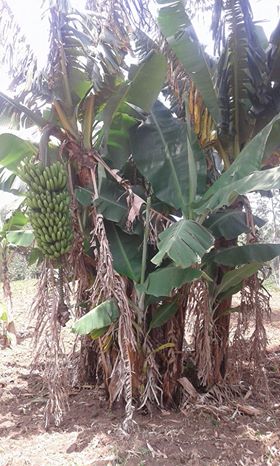
Bananas planted at the same time on the same day in a Zai hole. Photo: Salim Shaban August 2020. Western Kenya.
*
For more information, see the excellent ECHO technical note 78 (Motis et al 2013, search for “Zai pits” and click on “Zai pit system – ECHO community org”), which also has additional references. See also the excellent book “Gardening with less water” by David A. Bainbridge. ISBN 978-1-61212-582-4. Published by Storey, http://www.storey.com.
On a personal note, I have had good success when planting trees on farms and reforestation projects, as well as food plants and ornamental plants in gardens, in holes dug twice the size or more than the root ball/pot, adding compost to the planting hole, and making a ridge downslope to catch and hold water, followed by mulching 1 m wide, or mulching the whole area. This has worked well for me in a wide variety of soils and climates, and many types of plants, over many years.
*
Zai holes, biochar and carbon sequestration
Below is a brief concept outline for using zai holes, biochar and fuel efficient stoves for co2 fixation and long term carbon sequestration in soils in zai holes:
David Clode 10 May 2018.
*
News paper Zai hole project/experiment in Kenya
08 March 2018. Salim Shaban, head of the African Christians Organizations Network, and a church pastor, has just started a new Zai hole community project in Western Kenya, using news paper at the base of Zai holes.
In the illustration below, it can be seen that the news paper at the base of the hole covers the bottom of the hole and comes up the sides slightly, forming a basin to hold water and nutrients for longer. The side of the hole should not be covered by news paper, so that roots can also grow outward into the surrounding soil to take up whatever nutrients or moisture may be available.
The plastic containers for irrigation need to have a hole at the top so that water can be repeatedly added from the top, and the containers need to have holes made in them below the soil so that water/dissolved nutrients can get out into the soil. Clay pots do not need holes, but may need a cover or roof to reduce evaporation and to keep out animals, insects, etc. Tin cans with holes in them could also be used.
Soluble fertilizer, manure teas and human urine can be added to the water as appropriate. Sterilized human manure (perhaps sterilized previously in a solar cooker, or pour boiling or at least very hot water over the manure – the water could be heated in a solar cooker – about 70 degrees C will kill pathogens and parasites) is worth considering, and can be placed on the news paper at the base of the hole.
This technique concentrates water and nutrients in the root zone for longer, allowing greater uptake but without causing waterlogging, and minimises the loss of water and nutrients which could otherwise drain below and out of reach of the roots of crops.
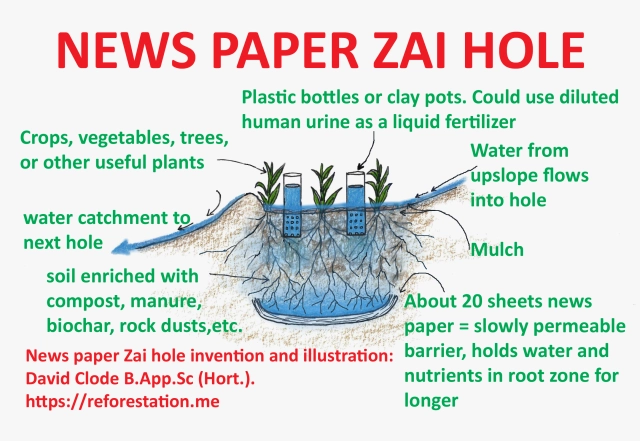
Newspaper Zai hole. About 20 sheets of newspaper at the base of the hole form a slowly permeable barrier. This idea is that this holds water and nutrients in the root zone for longer, but not long enough to cause waterlogging, which could occur with an impermeable barrier such as black plastic. Note that the plant roots can also grow out sideways into the surrounding soil to gain access to additional nutrients and water. Invention and illustration: David Clode.
I am helping him with the project, and the results have been amazing.
*
Zai hole and news paper Zai hole experiment results 08 August 2020
Experiments conducted by Salim Shaban and farmers in Western Kenya.
Results
Yields measured in kilograms fresh weight.
Maize
Zai holes (control): 8 bags of 90 kg’s (720 kg)
News paper Zai holes (experiment): 13 bags of 90 kg’s (1170 kg)
Experiment conducted over one acre.
Beans
Zai holes: 12 bags of 50 kg’s (600 kg)
News paper Zai holes: 20 bags of 50 kg’s (1000 kg)
Experiment conducted over half an acre.
Perhaps a useful rule of thumb would be that the news paper Zai holes yielded approximately 50% more than Zai holes without news papers at the base of the hole.
*
Zai hole experiment results 30 July 2019
These experiments compare the yield of three crops in standard Zai holes, and in News paper Zai holes, where 20 sheets of news paper are placed at the bottom of the hole in a bowl shape.
Results show that Zai pits with news paper at the base of the hole produce more than Zai holes without news paper at the base of the hole for all three different crops.
Experiment conducted by Salim Shaban and farmers in Western Kenya.
Results:
Yields measured in kilograms fresh weight.
Green beans
Zai holes: 4 bags of 90 kg’s (approx. 360 kg)
News paper Zai holes: 10 bags of 90 kg’s (900 kg)
Experiment conducted over half an acre.
Yams
Zai holes: 120 bags of 50 kg’s (6000 kg)
News paper Zai holes: 250 bags of 50 kg’s (12500 kg)
Experiment conducted over a quarter of an acre.
Soybeans
Zai holes: 4.5 bags of 50 kg’s (225 kg)
News paper Zai holes: 12 bags of 50 kg’s. (600 kg)
Experiment conducted over half an acre.
Zai holes generally produce 50% or more (up to 600%) compared to conventional row cropping, and the news paper Zai holes may produce even more (depending on the crop, soil type, climate etc.).
Disclosure: As much as I would have liked to have been there, I was not directly involved in any of these projects, so I cannot personally vouch for the results.
*
Zai hole project results 30 May 2018
Salim has contacted me with the results he obtained growing French beans (green beans) in three Zai holes with 20 sheets of news paper at the base of the hole, and three without newspaper.
Results:
Control:
Bean yield for Zai holes without news paper at the base: 1.5 kilograms.
Experiment:
Bean yield for Zai holes with news paper at the base: 4.5 kilograms.
Yield increase with news paper base = 300%.
Discussion
While this experiment has very limited replication, a yield increase of 300% is enormously significant and is considerably more than expected. I double-checked with Salim, and he has confirmed that the only difference is the 20 sheets of news paper at the base of the Zai hole, and that the watering and fertilizer regimes were the same for all the Zai holes, as well as the environmental conditions. Yields are likely to be different in different soils, climates and crops, either more or less.
It seems likely that the news paper has concentrated and held water and nutrients in the root zone for longer, but not long enough to cause waterlogging or root rot, while at the same time maintaining optimal soil aeration, all of which have greatly increased plant growth and food yield. Another factor in the success of this technique may be that evenly moist but aerated soil could have promoted the growth of beneficial soil life such as mycorrhizal fungi (which enhances nutrient and water uptake) and earthworms (the nutrients in earthworm casts are more available to plants and their tunnels provide improved aeration and water infiltration).
Results could also be similar for other beans and peas, such as cow peas, soybeans, peanuts, etc., which means an increase in the production of high protein food for small-hold farmers in developing countries, and drought-prone countries. Many types of peas and beans can also be dried and stored for long periods, improving long term food security.
This invention should work well in many other parts of Africa, as well as the Middle East, Central and South America, India and South-east Asia, perhaps greatly improving food production and food security for the poor worldwide.
The efficient usage of water is likely to increase yields in drier climates (and especially free-draining sandy soils, such as the Sahel region in Africa), and dry seasons, so the technique should also work well for growing vegetables and herbs in the dry summers of Mediterranean climate countries.
The technique may also work for vegetable gardeners in other parts of the Western/developed world, depending on climate and soil with best results likely in drier and hotter climates or seasons, and probably minimal or no improvement in soils which are already moist and fertile.
This invention with news paper at the base of a Zai hole could also be applied to fuel wood production, for example Sesbania sesban and other Sesbania species should grow very quickly with the moist fertile soil (Sesbania species generally grow best in moist to wet soils), producing fuelwood (and charcoal/biochar), animal fodder and mulch or compost. Sesbania could be rotated with crops. For fuelwood and animal fodder production, using human manure would increase organic matter and fertility, so there is little or no need for expensive fertilizers.
As an alternative to news papers, clay dishes could be a longer lasting slowly permeable water/fertilizer barrier. These could be made to fit within the diameter of the Zai hole, and flat with a 45 degree angle lip or wall, perhaps around 10 cm high, or a slightly concave shallow bowl shape. Baking the clay dishes in the sun may be enough to produce a slowly permeable membrane that could last for years. Ideally the dishes would be designed so that they can be stacked, with padding in between such as blankets, and be transportable, and so this could be a small business venture.
Another option could be to place the clay dish at the base of the hole, and make a fire in the dish to fire the clay in situ. In addition, a metal container with a litre or two of water could be placed over (or on) the fire (called a billy can in Australia) to heat water to near-boiling or boiling. Once the water is heated, and the can removed, human manure could then be added on top of the fire, and then hot water poured over the manure to sterilize it, killing any potentially harmful pathogens or parasites. The improved soil mixture would then be used to fill the hole, and the crops sown or planted.
It would be very helpful if a scientific research institute did similar experiments on a much larger scale with more replication, including testing many more vegetable and cereal crops, potential fuel wood species, trees, etc., in different soils and climates.
If anyone reading this would like to do the same or similar experiments, perhaps in different soils and perhaps with different plants, it would be very helpful. Please contact me to discuss what you would like to do, and I may add your experiment and photos to this page.
***
Zai hole project continued – I think this is a very exciting project because there are no administration costs associated with people in offices, it is all about local people getting on with the job in their own community. In addition, because the experiments are being done in Africa, and by people with local knowledge, there is a greater likelihood of widespread adoption of anything that is shown to work well.
Salim is also planning to spread any successful techniques through schools, and this web site receives tens of thousands of visits from people in nearly every country in the world, so anything learned can be adapted and adopted by small-hold farmers and backyard vegetable growers around the world. More to come as the project progresses. Some photos below:

Robert working hard digging Zai holes. Robert is obviously a man who is not afraid of hard work. Since digging holes is hard work, I think this is an opportunity for men to rise up to the challenge and dig Zai holes for their wives, mothers, grandmothers, sisters, aunts, etc. Guys, we all know it is always a good idea to make yourself popular with the ladies! Digging and preparing Zai holes could also be a business opportunity for one or a few enterprising and hardworking young men. Photo: Salim Shaban.
The holes in this project are 60cm (2 feet) wide and about 45cm deep. The newspapers are to go in the bottom of the holes to test if they will work in retaining water and fertilizer for longer, so that plants have greater access to these for longer, but hopefully not long enough to cause waterlogging and potential root rot problems. The theory is that the news paper will form a slowly permeable water barrier. This should reduce the costs and usage of both fertilizer and water and also increase plant productivity, both cheaply and simply.
I tested 1 litre of water into 20 sheets of news paper (news paper pushed into a sieve in a bowl shape, perched on the rim of a bucket, and it took up to 12 hours for all the water to drip through – theoretically allowing plants more time to take up water and dissolved nutrients in quick-draining soils, where the water and fertilizer might otherwise be quickly lost to soil below the reach of the plant roots). Twenty sheets may be more than is needed for this project, while in quick-draining sandy soils, more sheets could be better.
Compared to the sandy infertile soils and harsh dry climate of the Sahel region in Africa, this is a relatively fertile soil with a higher water holding capacity, and a wetter climate. This may mean that results may not be as obvious, but it is nevertheless likely that useful experience and knowledge will be gained.
Even if the Zai holes don’t produce significantly more food, the nutrient status of the food should be increased, and the crops may prove to be more resilient to pests and diseases with this technique. With ample water and nutrients crops may also produce food sooner, which could mean that they provide food before the burden of possible pests and diseases reduce productivity.
It may also be possible in some places, or with extra dry season watering, to grow fast maturing varieties (of maize for example) and get more than one crop in a year. In addition, there is the possibility of producing out of season food which may fetch higher prices.
Fortified organic fertilizer consisting of chicken manure, 15% human urine and biochar being added to the Zai holes. This should work well, and the inclusion of biochar also makes it Terra Preta trial. Human urine is a free and easily available liquid fertilizer. Another liquid fertilizer which could prove useful is liquid animal manure. This can be made by collecting the manure of animals that eat plants (not meat eating animals) such cows, goats, poultry and wild animals. The manure is placed in a hessian/burlap sack, or old pillow case, or stocking, and placed in a bucket of water. This is shaken around in the water, typically once a day for a few days to a week, and then applied to the crops.
I once grew some very tasty tomatoes using elephant manure!
*
*
*

Aaron is a young man who likes this idea and wants to do it on his father’s farm. Photo: Salim Shaban.
*
I think Sifuna’s choice to grow kale is an excellent idea, as kale is very nutritious and contains particularly high levels of vitamin A which is often deficient in the diets of people in Sub-Saharan Africa.
I think it would be good to try Moringa oleifera PKM-1 (and perhaps PKM-2) in Zai holes. Moringa produces edible and saleable pods and nutritious leaves, plus animal fodder, and highly sought after honey. In holes of this size, and with a buried plastic bottle or bottles with holes in them, or clay pots, used for irrigation, perhaps three or even five moringa PKM-1 plants could be grown per Zai hole. Another possibility that could work well would be two or three moringa plants, with one or two nitrogen-fixing pigeon pea plants Cajanus cajan growing taller and above them, in each hole. The hole would then produce for two or three years, or perhaps longer. Hopefully other plants such as Celosia argentata, amaranth and many others will be tested in the future.
Crop rotation could be practised with Zai holes. This could be growing a nitrogen-fixing legume such as cowpeas, followed by a staple such as maize/sorghum/millet or cassava, and repeated.
*
Zai holes could improve the value of a property for sale, or the improved soil from Zai pits could be dug up and taken if a farmer moves to another property. In South America, Terra Preta soil is valued and bought and sold between farmers.
“No one could make a greater mistake than he who did nothing, because he could only do a little”. Edmund Burke.
*
Sugar cane can be a valuable fodder crop, including both the juice and the tops.
*
For more visit:
*
*
Napier grass production – Tumbukiza technology
*
The De luxe Zai hole
The diagram below shows some possible modifications to increase the productivity of Zai holes in various soils and climates, for various purposes. See also the “Arborloo” page.
*

De luxe Zai hole diagram. Zai holes can increase the growth of grains, vegetables and trees, especially in infertile soils in drier climates or seasons. The De luxe Zai hole provides additional aids to growth. Invention and illustration by David Clode.
*
Zai holes are an effective but labour-intensive technique commonly used in the drier zones of West Africa, especially if the soil surface is compacted or has a hard surface crust, mainly to grow grains such as millet and sorghum, in infertile sandy soils and harsh climatic conditions. In these circumstances, Zai holes should also help trees to grow better in reforestation projects. Zai holes/Zai pits basically involve breaking through the surface crust, by digging a pit/hole, and mixing some animal manure (and sometimes trees grow from the seeds that were in the manure) or compost (and/or biochar) into the soil. In addition, some of the subsoil (or stones) is then used to make a surrounding ridge or rim to hold water (on flat ground), or on the down slope edge on sloping ground, in order to catch more water runoff from the paths in between the Zai holes.
The same or similar techniques have been used extensively and successfully by the author in suburban ornamental landscaping, and tree planting on farms and degraded land in Australia. For tree planting/reforestation projects on degraded sites, it would help if a few groundcover plants are also planted with the tree, (or in separate holes) to cover, mulch, and slowly improve the soil between the Zai holes. Ideally groundcovers would be species that root at the nodes (e.g. Ipomoea spp. and stoloniferous grasses), with at least some nitrogen-fixing legume species used.
A possible strategy or sequence for long term improvement of degraded soils to increase crop productivity, using Zai holes:
Initially trees could be grown in zai holes (or even better, Zai holes within demi-lunes) to form a woodlot (for fuelwood for heating and cooking fires, or fodder trees, or other purposes). In the Sahel region, for example, suitable trees could be Acacia holosericea, A. torulosa and A. tumida, and perhaps Cajanus cajun. These trees and shrubs also provide edible seeds. In slightly wetter regions, some other possibilities include Acacia auriculiformis, Gliricidia sepium, Leucaena leucocephala and Sesbania sesban. After around 2-10 years, the woodlot trees could be removed, having improved the soil by adding organic matter and nitrogen to the soil, as well as a surface mulch of leaf litter and twigs. Following this, Faidherbia albida (or perhaps Prosopis cineraria in India, and other Prosopis, Acacia and Parkia species in various parts of the world) trees could then be established from seeds or planted in Zai holes, at approx. 10 metre spacing. At around year 5 – 10, the soil should have been improved even more by the Faidherbia (or other trees) and crops could be grown under the canopy of the Faidherbia trees, with greatly increased yield (probably twice as much and perhaps much more with Faidherbia trees).
Direct seeding Faidherbia albida in the Sahel final
Zai holes: Size and shape

An example of a rock dust, made from volcanic basalt rock. This has been tested in North Queensland by James Cook University, and proven to provide long-term fertility improvement to a variety of soils in a high rain fall, tropical climate (where nutrients tend to be leached).
Zai holes can be made in the shape of a circle or a square, or could be a rectangular trench dug horizontally along the contour to catch water which runs off from the paths. In very dry areas, there are usually larger paths (a greater surface area to catch more runoff), and fewer Zai holes. Over time, the manure which has been mixed in is usually further distributed through the surrounding soil by termites, and/or earthworms. Other appropriate amendments could include compost, vermicompost, fertilizers, biochar, rock dusts, burnt bone, clay in sandy soils, etc.
A similar system to Zai pits is used in East Africa, called Tumbukiza, where goat or cow manure is mixed into the holes, and is commonly used to grow Napier grass, Cenchrus purpureus/Pennisetum purpureum, (or Andropogon gayanus, or Megathyrsus maximus/Panicum maximum or Brachiaria) in cut-and-carry fodder systems for stall-fed dairy cows.
The width and the depth of the holes varies considerably, and does not appear to make a great difference to plant growth, however larger holes would store more water, and be more suitable for larger plants, including trees, or a greater number of individual plants. In a trial in Kenya growing cowpeas square holes 60cm width, but with depths of 30cm, 45cm, and 60cm were compared, and 45cm depth was best. Click on the link below:
In Western Kenya, a depth and diameter of 60 cm (2 feet) is popular, with paths of the same size between the plantings (Orodho, 2006). Zai holes can be as little as 20 cm in diameter and 10 cm deep, while Tumbukiza used to grow the very large Napier grass in Kenya, can be as much as 90 cm deep, and up to 90 cm long. See the Napier grass photo below.

Me standing in Napier grass or Elephant grass, Cenchrus purpureus/Pennisetum purpureum, growing five metres tall, without irrigation or fertilization. Cairns, North Queensland, Australia.
The size should take into account what is ergonomically easy for management, such as reaching down or across for watering and weeding, and that the roots of most vegetables only go down to a depth of around 30 cm (12″), or at least that is where most of the roots are concentrated, although maize roots can grow down to a metre (yard) or deeper. Many plant species absorb most of their water and nutrients from the top 60 cm (2 feet) of soil. Larger holes require more work, which is a consideration where many holes are to be dug, and in Africa where the farmer may be a woman and perhaps not as strong as they were in their younger years.
One idea to reduce labour is to use a draft animal/s to rip lines that criss-cross the area, so that zai holes can be more easily dug where the rip lines intersect. Generally hoes or mattocks are used to make the holes, but in some soils (but not very sandy soils), and for some people, a garden fork may be easier, since you are using your body weight to push the fork into the ground, and levering the fork upwards (using the principle of the lever), rather than the relatively hard work of lifting a hoe above your head, and then striking the ground to make holes.
Cost/effective Zai holes
Another labour saving technique could be to dig holes about 20cm deep, and then use a garden fork pushed as deeply as possible (30 cm) into the base of the hole, and then levered back and forth to create cracks. A slurry of compost or manure and possobly clay or silt, is then watered into the cracks. Roots should grow into these cracks, so they have at least some access to approx. 50 cm depth, with the harder work of digging only to 20 or perhaps 30 cm depth. I have had reasonable success growing vegetables in heavy clay subsoil with this “fork levering” technique (compost in the cracks, and then compost, and then mulch, on the soil surface).
*
If four stakes are to be used to enclose each hole with clear plastic or non-woven polypropylene fleece, then fewer, larger holes would be more economical, since four stakes (and other materials) are needed for each hole. If stakes and a covering of plastic or fleece are to be used, then a large diameter of about one metre (one yard), and a soil depth of 30 cm (1 foot) for smaller herbs and vegetables, and a depth of 60 – 90 cm (2 – 3 feet) for larger grain crops, should work well.
The size and shape of paths should allow easy access for people, and possibly wheelbarrows, mowers and trolleys. In dry areas, the most important function of paths may be to provide a large and impermeable surface area to collect water. In wetter areas, and/or where space is limited, the area covered by paths should be as small as possible. Plants could also be grown on paths, to be mowed with a lawn mower and produce mulch for example, (perhaps subterranean clover, Biserrula pelecinus in Mediterranean climates, or other nitrogen-fixer), or to attract beneficial insects such as bees (e.g. many groundcovers in the Asteraceae family, legumes, Phyla/Lippia nodiflora). However, in drier areas, plants grown between the holes would reduce runoff into the holes.
Zai hole productivity increases
Reported increases in plant productivity for Zai holes and Tumbukiza range from 40% through to 600%, and should be further increased by the modifications suggested for the “De luxe Zai hole”. The higher figures would be from results in dry, infertile soils, often with a hard surface crust. In good soils with favorable climates, a lower response should be expected.
Some more productivity figures for zai holes, and microdosing of fertilizer from Motis et al 2013 (ECHO technical note 78):
Microdosing of fertilizer: “Smallholder farmers – about 25,000 of them – in West Africa have seen 44% – 120% increases in sorghum yields and 50% – 130% increases in family incomes (ICRISAT 2009).
Zai holes in a high annual rainfall (1300 mm) area of the Ethiopian highlands, combined with nitrogen fertilizer: “Zai pits, in combination with additions of nitrogen, increased potato yields 500% – 2000%; bean yield increased by 250% with zai pits. The pits themselves contributed more to yield increases than the nitrogen inputs, indicating the significant role that water can have on crop growth and the use of existing soil nutrients. Importantly, farmers earned 20 times more income than the labor required to dig the pits”.
Zai in West Africa: “yield increases of 300 – 400 kg/ha in a year of low rainfall and as much as 1500 kg/ha in a year with good rainfall were observed by Kabore and Reij, 2004. With rainfall amounts ranging from 359 – 449 mm, over three rainy seasons, sorghum yields in farmer’s fields increased from 319 – 642 kg/ha without zai to 975 – 1600 kg/ha with Zai (Sawadogo 2011)”.
Shelter to increase plant growth

Non-woven polypropylene garden fleece (also called frost protection blanket). This material provides some shade, and protection from extremes of hot sun, winds, sandblast etc. In addition, the material is relatively cheap, and could also perhaps be provided by overseas aid organisations as an alternative mosquito net material.
In the modified or de luxe design illustrated above, the clear plastic (polythene) in cold conditions, or polypropylene garden/horticultural fleece/frost protection blanket (see photo on the left) in hot conditions, would provide protection from hot or cold winds, sand blast (especially young seedlings), extremes of temperature, low humidity, and high solar radiation, where needed.
To gain an appreciation of what shelter can do in colder climates (the U.K.), the shelter/greenhouse effect of plastic tree guards increased the growth of young oak trees in the first three years, growing five times taller and 6.2 times the stem volume compared with unsheltered trees (Tuley, 1985). Note that this effect could be in addition to the figures of 40 – 600% productivity increase given above for an unsheltered Zai hole (at least in colder climates or seasons).
Mulch
Mulches of plant materials (organic mulches) on the surface of the soil generally keep the soil cooler, insulated against temperature extremes, and moister for longer. These conditions usually result in a proliferation of earthworms (which increase water infiltration, soil aeration and nutrient availability); and promote the growth of mychorrhizal fungi, which can greatly improve the efficiency of water and nutrient uptake by plant roots. Mulches usually reduce weeds (which compete for light, water and nutrients, and so reduce plant growth) and need to be topped up as they decompose.
Mulches can greatly increase plant growth. For example, a mulch of wild grasses and banana leaves increased yields of coffee in Ethiopia by 22% – 93% (Troeh et al, 1980). In my experience, mulches of pea straw or alfalfa (lucerne) hay are particularly good for growing vegetables, and encouraging a population explosion of earthworms, with all the benefits they provide (see the page on this web site about earthworms). The leaves (preferably small leaves) and twigs of most nitrogen-fixing plants are likely to be good, e.g. from legumes, casuarinas, alders and Azolla (however Azolla decomposes quickly and is probably best used as fodder or to make compost). Gliricidia sepium for example, is tried and proven. Some Acacia species with large phyllodes (“leaves”) may contain tannins and may not be as good, or will require partial composting before use (this would also apply to most wood chips, barks, and sawdust, which may contain toxins and require some composting with additional nitrogen and possibly lime or dolomite).
The leaves of Tithonia species are high in both nitrogen and phosphorus (and the related Montanoa, sun flowers, Jerusalem artichokes, and other daisy family plants may be similar) and should make a good mulch. Tagetes minuta or khaki weed is high in potassium (2%). Tithonia, Montanoa and Tagetes are all in the daisy family Asteraceae, so it is reasonable to assume that other plants in the daisy family may have leaves high in NPK. Some grasses used as mulch also seem to be good with vegetables, such as Guinea grass and sugar cane leaves/bagasse. Leaves from fig trees and Grevillea robusta may work well, and the cladodes (“leaves”) of casuarina are high in silica and long-lasting as a mulch layered over the top of other mulches or compost, and allow for easy infiltration of water.
Mulch from plant materials should be kept away from plant stems as this may promote rotting of the stems, however, some plants such as maize and tomatoes, will benefit by growing additional adventitious roots if mulch or compost is piled up against the stem, later in the growing season.
Black plastic mulch (polyethylene/polythene) can be a very useful mulch in colder climates or seasons.
In a trial undertaken by the University of Arkansas the use of black plastic mulch (compared with no mulch) resulted in an average increase in vegetable yield of 90%. Bushbeans, cucumbers and straight necked squash exceeded 100%, while purple hull peas only increased by 16%. Crooked neck squash had a 77% increase in yield, and sweet corn produced an increase of 83% in the number of ears. These very high figures should porbably be viewed as a best case scenario.
In some climates, where it is cold in winter and hot in summer, it may pay to use black plastic mulch initially to warm up the soil, which could then be removed and replaced with an organic mulch as the weather and soils get warmer.
See also the “Earthworms, Mulch, Compost” page.
Carbon dioxide enrichment
If the hole is enclosed on all sides by clear plastic (and preferably on top), partly decomposed compost (preferably made of leaves and twigs, to replicate the mulch found in a rain forest) could be used as a mulch. This would give off carbon dioxide, which is heavier than air, which would pool at the base, and should help to get low-growing seedlings/young plants off to a good start. An indication of the likely amount of carbon dioxide is suggested by research in a rain forest in Puerto Rico, where “At the ground surface, respiration maintained carbon dioxide concentrations of 400-620 ppm compared with 320 ppm in the free air above the forest” (Odum et al 1970, in Richards 1998). See also the article: vegsand , page 6 and 7.
Partially decomposed compost should preferrably not be in direct contact with the soil, as this may cause nitrogen draw-down, where micro-organisms outcompete plants for the nitrogen they use in breaking down plant materials (and so plant growth is reduced due to nitrogen deficiency). It would be best to place fully decomposed compost onto the soil first, and partially decomposed compost on top of this, preferably with additional nitrogen, which could come from human urine. Once the partially decomposed compost has fully decomposed, more could be added on top to keep up the carbon dioxide concentration, but results are likely to be diminished as the plants grow taller, and become adapted to CO2 enrichment. CO2 could also be produced by a solution of water, a sugar of some sort and brewer’s yeast, in shallow containers placed around young seedlings.
CO2 enrichment should increase growth by 10% or considerably more – click here for an example of the results that can be achieved with young vegetable growth in a CO2 enriched environment (52 days at 1250 ppm) :Plant response to Co2 enrichment
Watering
Water barriers to potentially increase plant growth:
The optional water barrier of newspaper should be beneficial in dry situations, in free-draining sandy soils, or for vegetables/grains/plants that have a high water requirement. Around twenty sheets of newspaper in a bowl shape at the bottom of the hole (e.g. around 30 – 60 cm deep/1 – 2 feet deep) form a slowly permeable barrier, which should prevent water from draining away for six or more hours (up to 12 hours – I tested it). This will give the plants time to use most of the water, while excess water will still drain away eventually, avoiding waterlogging, which most vegetables do not tolerate well and can result in root rot. For plants that grow best in very wet conditions, an impermeable layer of plastic sheet or similar could be used. See the article “Growing vegetables in sandy soils”, vegsand page 5 and 6. Water barriers in dry, sandy soil should increase productivity by at least 35%, and possibly a lot more for plants that normally have a high water demand.
Zai holes are designed to catch water runoff, but additional watering is possible and may increase growth. Drip irrigation is an option of course, but buried plastic bottles, waxed cardboard milk cartons or tin cans with added small holes in them can be filled to irrigate the plants, and could include soluble fertilizer such as human urine. Clay/terracota pots or pipes could also be used (Garrity pers.com.), partly or largely buried, with a moveable lid such as a plastic plate on top (to reduce evaporation losses – see photo below).
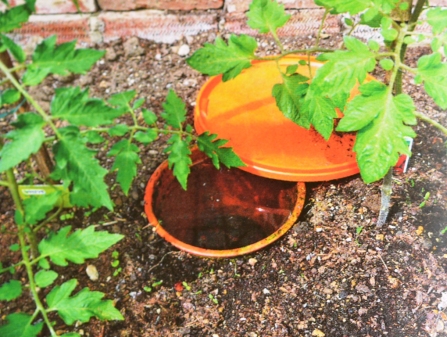
Terracotta pot with plastic plate/lid used for irrigation. Photo: Maddy Harland, Editor, Permaculture Magazine.
The photo above, and the quote below, come from the article “Mini forest garden greenhouse”, by Maddy Harland, Editor, Permaculture Magazine no 77, Autumn 2013, pgs. 59-60:
“Inside, I have adapted ‘Ollas’, a 4,000 year-old irrigation system originating in Africa. It comprises a 25.5mm (10 inch) buried porous terracotta pot (above) with plates for lids. In Africa these would be beautiful terracotta bottles, but pots work fine. The drainage holes are plugged with a wine cork and the pots are filled with water. As the surrounding area dries out, water is sucked through the terracotta into the soil and the roots of the plants wrap themselves around the pots. This appears to be working well and I intend to add to the collection next year. The system is a simple and cheap way to help irrigate the greenhouse and it can also be used in any outdoor veggie bed. I hope it will prove especially useful when I am away on holiday for a few days.”
Fertilizing
“In summary, the zai system allows farmers to concentrate both fertility and moisture close to crop roots” Motis et al 2013.
Micro doses of fertilizer (typically a bottle cap full per plant/hole) can be placed precisely in the root zone in Zai holes, which is very cost effective, potentially promoting the growth of crops, and/or early growth of trees, see http://www.icrisat.org/impacts/impact-stories/icrisat-is-fertilizer-microdosing.pdf . A newspaper barrier (about 20 pages) beneath the roots of vegetables or grains (but not trees, where the newspaper could impede downward growth of roots, which may be a major problem for some species such as Faidherbia albida) should also reduce leaching losses of expensive fertilizer/nutrients, and could be very effective in well-drained sandy soils.
Various chemical and organic fertilizers, rock dusts etc., could be used, but the increased nutrient availability of vermicompost (compost made using earthworms) should give excellent results. Vermicompost can be enriched with small amounts of commercial fertilizer (or rock dusts, or burnt bone, wood ash), so that the vermicompost has a higher nutrient content, as well as higher nutrient avilability, and since the fertilizer should form a complex with humus in vermicasts, leaching losses of fertilizer should be reduced. For more info on “enriched vermicompost” some research has been done in India, click here: http://www.jtropag.in/index.php/ojs/article/viewFile/80/75 , or visit the “Earthworm” page – click on the button in the menu bar at the top of this page. See also “Human manure and urine” below.
Some plant combinations for Zai holes, Zai holes within demi-lunes and circle gardens:
Central and North American people traditional grew “the three sisters” in a circle garden consisting of a mound of soil and compost. Zai holes should suit the growing of the “three sisters” of a complementary mix of maize, climbing beans and squash/pumpkins/zucchini (a compact form of pumpkin may be better). In theory the maize (or perhaps sorghum or millet) provides support for the beans to climb (beans planted 2-3 weeks later), and the beans add nitrogen to the soil, which aids the growth of the grains and pumpkins (the pumpkin leaves help to shade out weeds). This is also a nutritious combination, with carbohydrate from the maize, protein from the beans, and carotene from the orange-fleshed pumpkins. The grains, pumpkins, and some types of beans can also be stored, providing food security, and some suggest that this combination was not grown for fresh harvesting, but was left to the end of the season, primarily to provide stored food through a cold or dry winter.
Another plant combination which should work would be maize or sorghum and pigeon pea Cajanus cajun.
*
“In an ECHO zai trial in South Africa, combined grain yield of cowpea+sorghum was as much as threefold higher than sorghum alone”. The two species were grown in separate holes in alternate rows, which has the added benefit of allowing for crop rotation, plus, nutritionally, the cowpeas are higher in protein. Cowpeas may also provide a harvest of food before the sorghum harvest. Lablab beans may provide a later harvest than the sorghum (Motis et al 2013). Therefore, alternate rows of sorghum, then cowpea, then sorghum, then lablab, all repeated, could spread out the harvest and provide food security. The lablab and cowpeas also produce organic matter (lablab up to 10 t/ha, and cowpea, 3 t/ha), which could be used to make compost, used as mulch, or livestock could feed on the crop residues, as long as they are kept there long enough to redeposit the crop residues as manure on the same field.
The greater biodiversity (using three different plant species in the same area) could also help by providing habitat for beneficial birds and insects, and this may reduce pest and disease problems. A couple more possibilities for rotation and increasing biodiversity, and food security, could be okra (or roselle), yacon and cassava.
More plant combinations and techniques:
Faidherbia and lablab, velvet bean or jackbean:
Faidherbia trees could be established at around 10 metre spacing, perhaps with seeds sown in zai holes that have had one season of jackbean, lablab or velvet bean growing in them. The top growth could provide a surface mulch, and the downward growth of the roots of the Faidherbia trees may be facilitated and hastened by growing where the decomposed roots have paved the way.
Maize and Desmodium intortum (green-leaf desmodium) combination/intercrop:
“maize yields were constantly (consistently?) higher in maize – desmodium than maize monocrop and other maize – legume intercrops”. (they tested a comprehensive range of legumes and desmodium was the best. Legumes tested included: Phaseolus vulgaris, Vigna unguiculata, Crotalaria ochroleuca, Vigna radiata and Arachis hypogaea). Green-leaf desmodium can be grown from seed or cuttings, and may need inoculating with appropriate nitrogen-fixing bacteria. See also desmodium in push-pull technology and for the suppression of striga.
It is possible that Desmodium intortum could also be grown in Zai holes to potentially enhance the growth of sorghum, sugar cane, or Napier grass.
Ndayisaba et al. (2021). “Intercropping desmodium and maize improves nitrogen and phosphorus availability and performance of maize in Kenya.” Field Crops Research vol 263. 1 April 2021, 108067.
*
Human manure and urine
In places where famine is a recurring problem, and/or where organic matter and nutrients are unavailable or not affordable, human manure could be used in Zai holes or circle gardens, or human manure could simply be used for the satisfaction of recycling a problem waste product into something of value. It takes about a year to ensure that all pathogens have died off (two years would be better – Jenkins 1999), so green manure/fallow plants could be grown instead of human food plants, to further improve the soil for a year or two, with the tops of the plants cut off at or just below soil level, and then used as mulch or dug into the soil for newly planted vegetables/grains. Another option would be to grow cut-and-carry fodder plants for animals, or fuelwood (e.g. Sesbania sesban, pigeon pea – Cajanus cajan, Moringa oleifera, grasses), for the first year or two.
Alternatively, dry leaves, paper and kindling (small sticks) could be placed in the hole, with human manure on top, and then more kindling on top of the manure, and then burnt to sterilize the manure. Ideally the hole would be covered to induce pyrolysis. This would also add beneficial charcoal (and perhaps ground up burnt bone which has a high phophorus content and availability) and ash (usually containing potassium, calcium, magnesium) to the Zai hole (see also the “Charborloo” on the “Arborloo” page, and the “Biochar, Terra preta” page), before planting vegetables or grains.
Human manure could be deposited into a plastic bowl, the base of which has been lined with about twenty sheets of newspaper. After each visit, the manure is covered with soil, saw dust, rice hulls or similar for hygiene purposes and to prevent odour. The manure and newspaper would then be carefully placed (wearing rubber gloves specifically for the purpose), newspaper down, into the bottom of a Zai hole which has a concave (bowl shaped) base.

A plastic “washing up bowl” lined with 20 sheets of newspaper, for defecation. The whole lot can be placed at the bottom of a hole which has a concave base, and then plant trees or other plants. Household food waste could also be added, such as egg shells and vegetable scraps.
A couple of litres of water can be heated (to 80-100 degrees C) in a solar cooker or on a fire, and the hot water poured on to the manure to kill harmful organisms. The Zai hole would then be filled with soil which has added compost, rock dust etc., and planted. Another option would be to heat treat the bowl of manure in a solar cooker which is kept specifically for that purpose.
Diluted human urine could be used on Zai holes as a free and available fertilizer, usually diluted 1 part urine to 5-10 parts water. See photo below:
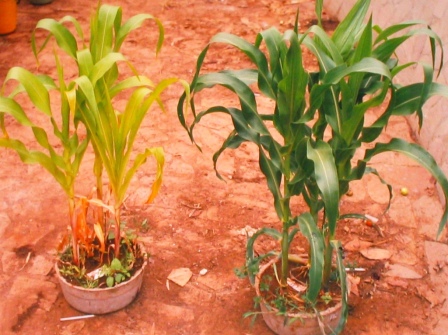
Maize grown with human urine. On the right – 3:1 mix water:urine, .5 litres, 3 x week. Photo: Peter Morgan. Sept. 2002, Harare, Zimbabwe.
Zai holes for producing mulch, compost and fodder
Zai holes can potentially be planted with plants to produce mulch, material for composting, and fodder for livestock. Two species could be combined, for example, a fast growing grass e.g. Napier/Elephant or Guinea grass, plus a legume, e.g. Desmodium intortum, pigeon pea, or Gliricidia or a sesbania species. Human manure could be used.

Guinea grass Megathrysus maximus/Panicum maximum and crotalaria growing together. A combination such as this could produce fodder, mulch or material for compost.
*
See also the Arborloo page
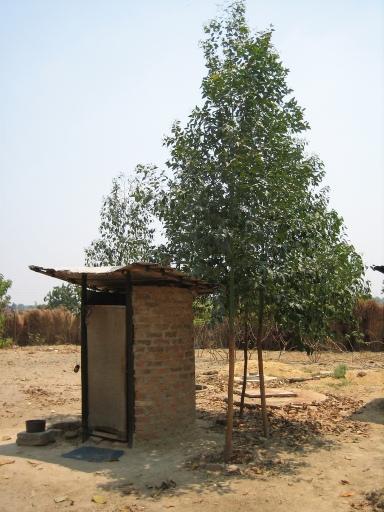
Eucalyptus trees growing around an arborloo, with additional nutrients supplied from diluted human urine. Photo: Peter Morgan. Harare 2010.
*
Conclusion
Zai holes generally substantially increase plant productivity, and a combination of some or all of the modifications suggested to create the news paper and De luxe Zai holes should increase productivity even more, for a wide range of plants. The relatively recent research and developments showing greater productivity for Zai holes within demi-lunes, and the sugar cane ring pit culture technique, are promising.
*
“If we could turn official and popular interest
away from the grandiose projects
and to the real needs of the poor,
the battle could be won”.
E. F. Schumacher. “Small is Beautiful”.
*
For more info:
maize-production-with-manure-amended-compost
Jenkins, Joseph C. (1999). The Humanure Handbook. Jenkins Publishing. ISBN 0-9644258-9-0. Pgs. 164, 194.
Miles, Tom (2007). “Microcatchment rainwater harvesting systems: Zai planting holes.” http://biochar.bioenergylists.org/nepad19zai2004
Orodho, Apollo B. (2006) “Tumbukiza technology: an alternative method of Napier grass production.”
http://www.fao.org/ag/AGP?AGPC/doc/Newpub/napier/tumbukiza_method.htm
Richards, Paul W. (1998). The tropical rain forest: an ecological study. ISBN 0 521 42194 2. Pge. 214.
Rinaudo, Tony. “Zai holes harness termites to increase crop yields.” See “Dryland techniques and mulches”, in the book “From Amaranth to Zai holes”, www.echonet.org
Troeh et al. (1980). Pge. 676.
Tuley, G. (1985). “The growth of young oak trees in shelters”. Forestry, Vol. 58, No. 2, 1985. www.forestry.oxfordjournals.org.
*
Roof garden:
A simple design for a hessian/burlap bag garden on a sloping roof
In this (untested) design, a hessian bag or old pillowcase is filled with good quality potting mix, or compost with some good topsoil (which could be pasteurised before use). The bags are placed near the bottom of the roof for easy access for maintenance, and to provide a large water catchment area above the bags. Clay, cement, or polyurethane foam ridges direct additional water to the bags when it rains. Watering could be by means of plastic bottles or tin cans with holes in the base, or clay pots, and fertilizer could include human urine. The bags could be placed on a sheet of plastic, to protect the roof. On top of this, an old blanket or towel would collect fine particles and keep the roof cleaner. However, the bag may slide on the plastic, and the bag may need to be fixed into position.
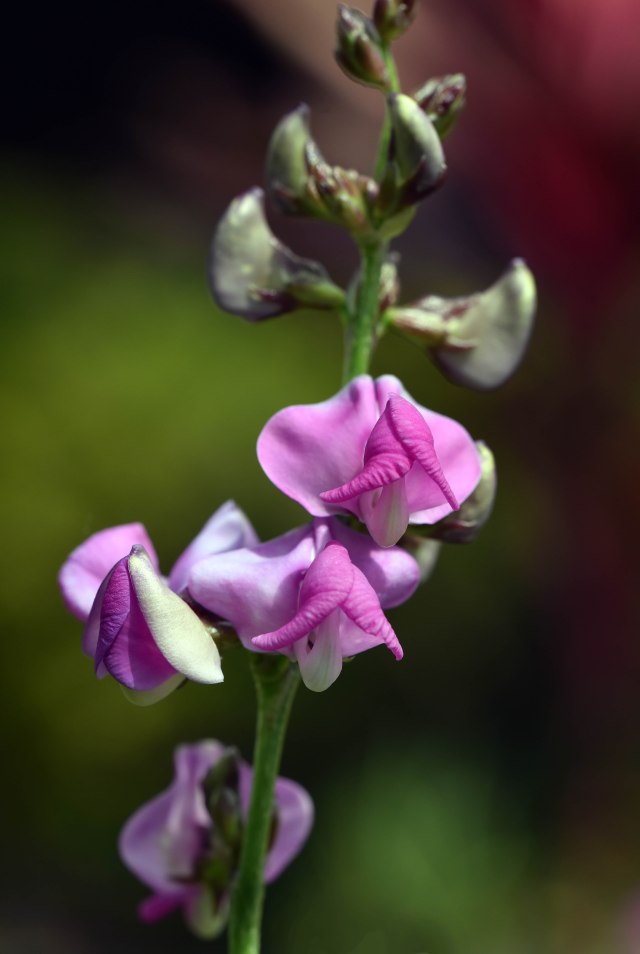
Flowers of Lablab purpureus, a nitrogen-fixing ground cover and/or climber, which may be suitable for a roof garden, producing edible beans. Photo: David Clode.
Roofs are a tough environment for plants, with high solar radiation, hot and/or cold winds, frost etc. Only the toughest, most adaptable plants should be used, and only low productivity should be expected, however, something is still better than nothing. Plants could be chosen not only for food, but also perhaps fodder, nectar for bees (honey), to attract beneficial wildlife, medicines, ornamentation etc. Groundcovers on a roof can also keep a hot house cooler, and provide insulation against the cold. See also the article “Growing vegetables in sandy soils” – click here vegsand. For more ideas on growing food in limited space, click on the “Stacked gardens” button above, and the “Arborloo” button.
Moringa oleifera
Moringa oleifera cultivars PKM-1, PKM-2, or other smaller varieties, should grow well in Zai holes, circle gardens, bag gardens (sack gardens) and possibly roof gardens. This very useful, tough and fast-growing plant produces edible “drumsticks” (like bean pods), and nutritious edible leaves, animal fodder, and nectar for bees. It can be grown from seed, or from large cuttings, around 10 -15 cm diameter, placed directly in the ground, early in the wet season.
An incidental roof garden
These plants have established themselves naturally on a roof at Paradise Palms golf course, Palm Cove, Cairns. The roof has collected some leaf litter, and the seeds have presumably arrived from birds depositing them. Pipturus argenteus (centre) and Homalanthus novoguineensis (left) are two classic colonising/pioneer/regrowth plants in the rain forests of North Queensland. How the sugar cane (right) got there is anyone’s guess – perhaps someone was eating the sugar cane and then threw it up onto the roof.
*
Vertical gardens/Green walls
It is definitely worth seeing Patrick Blanc’s amazing work and book:
Blanc, Patrick. 2011. The vertical garden: from nature to the city. W. W. Norton & Company. ISBN 978-0-393-73379-2.
*
*
A green wall (mostly bromeliads) on the side of a farm shed, Mount Uncle, North Queensland, Australia.
*
*
*
*

An increasing assortment of plant containers are becoming commercially available for vertical gardening. Photo: David Clode at the Bunnings Cairns hardware store.
*
*
“No individual has any right to come into the world
and go out of it
without leaving something behind”
George Washington Carver
***
Thank you for visiting.
David Clode.
Reforestation.me



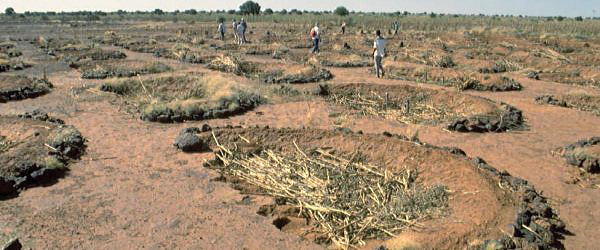


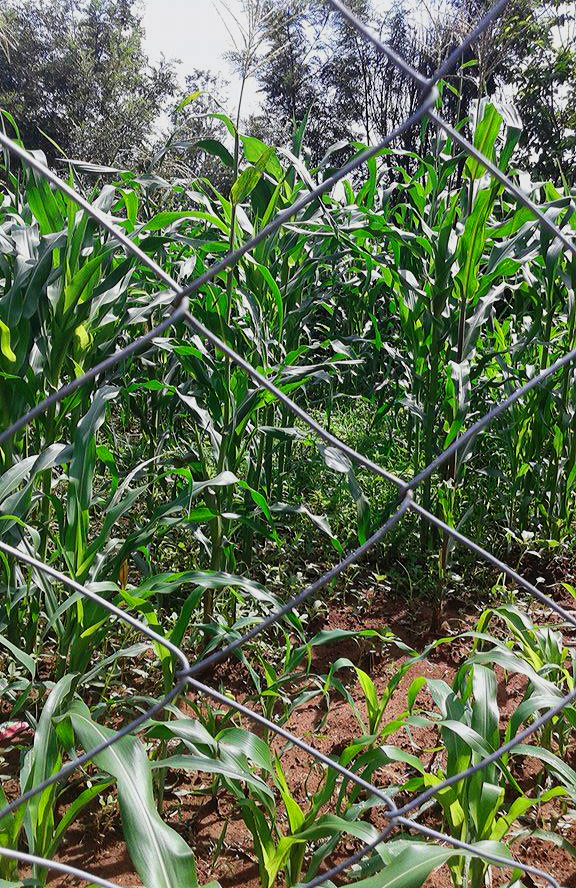


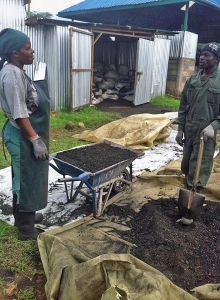
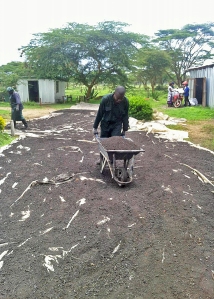

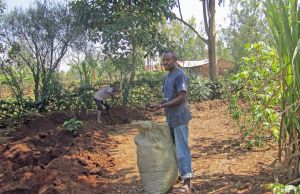
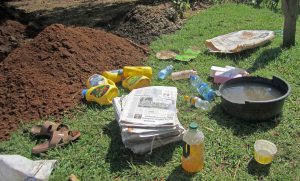



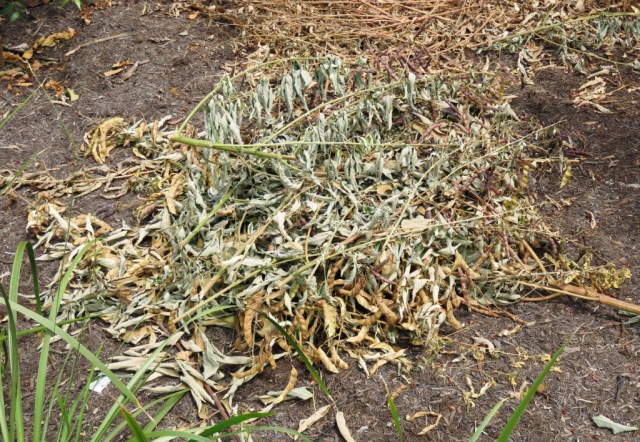

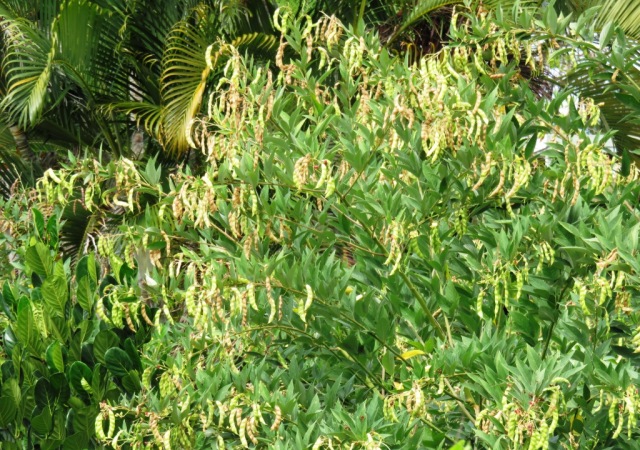
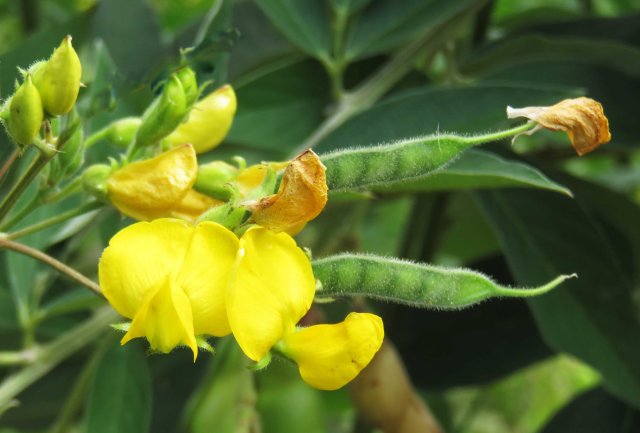

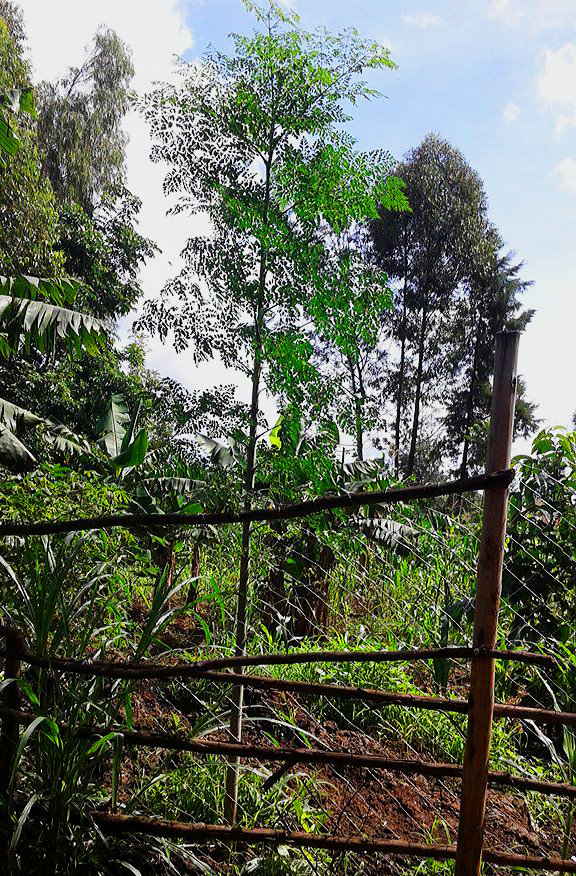
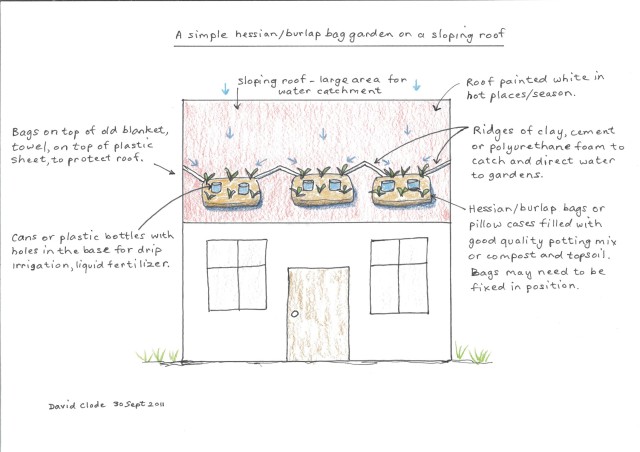


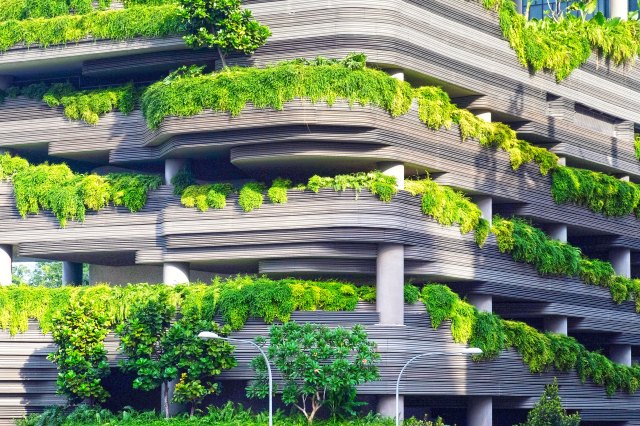
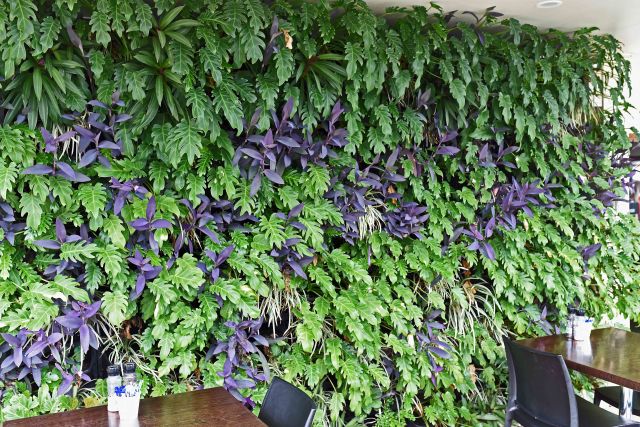
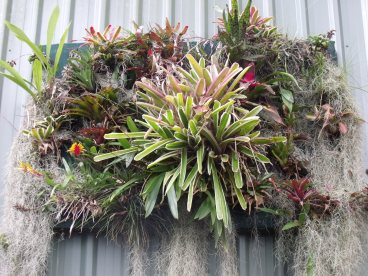
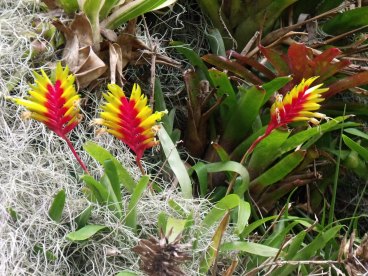

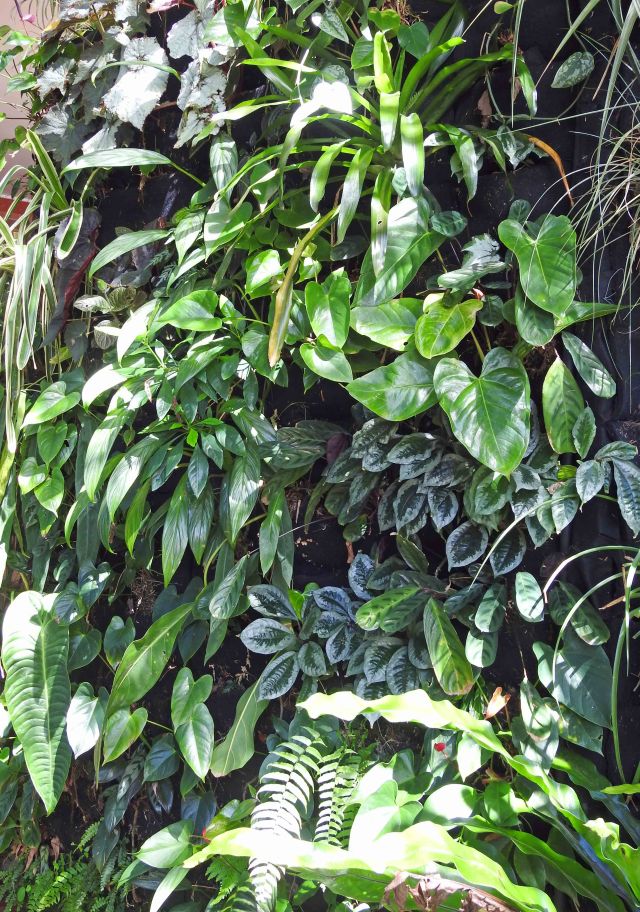
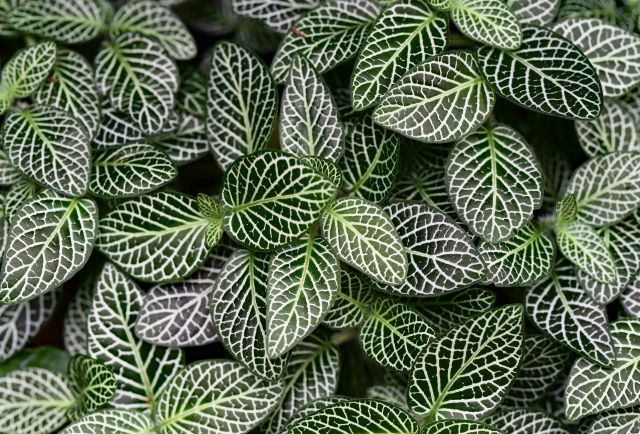

Thankyou for helping out, great info .
LikeLike
I have been checking out many of your posts and i can claim pretty nice stuff. I will definitely bookmark your site.
LikeLike
Roof garden, Zai holes, Circle gardens | reforestation.me I was suggested this blog by my cousin. I am not sure whether this post is written by him as no one else know such detailed about my trouble. You are wonderful! Thanks! your article about Roof garden, Zai holes, Circle gardens | reforestation.meBest Regards Craig
LikeLike
I appreciate your comments, thank you all.
LikeLike
Please teach the rest of these internet holiagons how to write and research!
LikeLike
Excellent article. Been working in agriculture in Southeast Asia for nearly 40 years but never heard of zai holes. But, we did not need them until now. Will recommend them in the future for vegetables and reforestation. Thank you.
LikeLike
Hi Tony,
Thanks and best wishes.
David Clode
LikeLike
Wonderful detail! I’m very impressed by your writing. If I used this method would I need to dig the zai holes each year with more sheets of newspaper and organic matter? I’m trying to decide what kind of system to use for a veggie garden in central Australia.
LikeLike
Hi Aia,
Good question. Firstly, I think that Zai holes would work well in central Australia, due to the similarities to the Sahel region in Africa where they were invented. The basic Zai hole does not have newspaper, and you could just do that, but I think the newspaper would help to retain water and nutrients in the root zone for longer. In a warm, wet, nutrient rich environment, decompositon is likely to be relatively fast, but I suspect that redigging the hole and replacing the newspaper might only be done every two years. This would be a good opportunity to add more compost anyway. Even if the newspaper has completely decomposed, it should leave a thin layer of humus which may still help to retain water and nutrients. I would probably top up the mulch on the soil surface, once or more a year, as this would also add nutrients, retain moisture, and reduce weeds which compete for nutrients and moisture.
If you decide to use newspaper zai holes, I would greatly appreciate it if you could get back to me with the results, either good or bad. If you tested Zai holes against more traditional growing methods, and kept records and took photos, the results could be very helpful to people who do not have enough to eat in developing countries.
My email is daveclode@hotmail.com
Good luck!
David.
LikeLike